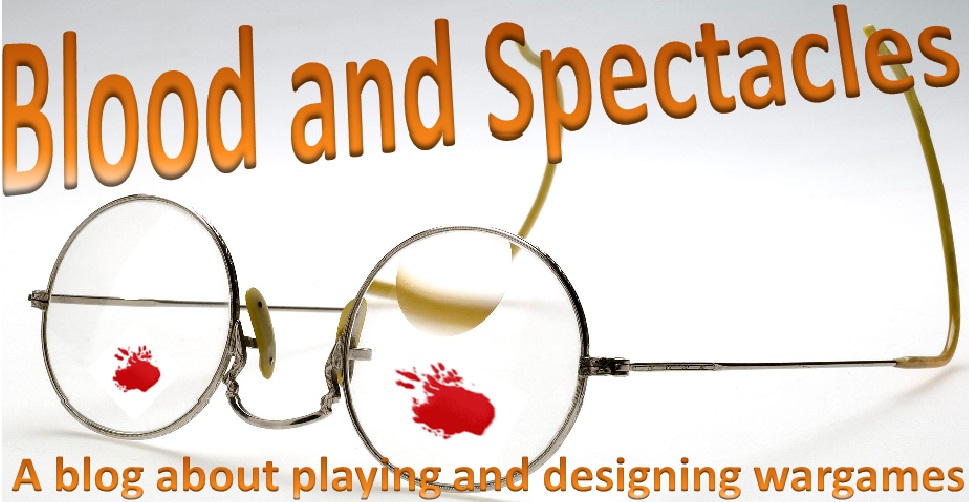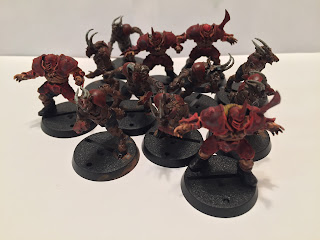I have been wanting to play a game of
Blucher for about two years. I know almost nothing about the
Napoleonic Wars and have never really wargamed them before. In
truth, it was a bit intimidating with all the foreign unit names,
various army structures, and do not even get me started on the
uniforms. However, the idea of the “Big Battles” (along with the
big hats) was appealing to me.
When I first saw and heard about
Blucher, it seemed like a good fit for a newbie to Nappies like me.
Most of the square, line, column, stuff was abstracted due to the
game scale. Uniforms and army structure were as well. In addition,
it was designed to be playable with cards so I did not need to start
a big new collection of models. Two years later, I finally got up
the scratch to pick it up and the 100 Days supplement.
I gave the basic rules a quick read
through and found them easy enough to understand. From there, I went
to the
Honour Website and downloaded
Along the Danube
the introductory game. This gives you a basic table lay out, some
army cards, and a scenario to get you started. Since my usual
wargaming buddy and myself knew almost nothing about the period and
the warfare of the time this seemed like a pretty good place to
start. Plus, the rules themselves encouraged starting here before
moving on. Who was I to argue?
Normally at this
point, I lay out the scenario and the forces, but you can find all of
that on Sm Mustafa's website at
Along the Danube so I am going
to skip it this time. Plus, I don't want to embarrass myself too
badly by completely screwing up the terminology.
As the attacker, I
was the French with 3 infantry corps and a reserve cavalry corp. By
opponent was the Austrian defenders with 2 Infantry Corps and a mixed
reserve corp including Guards, artillery, and cavalry units.
As the French, I
had to get hold of two objectives on the Austrian side, or cause them
to break by routing 8 units. The Austrians had to stop me and could
defeat me by routing 8 units as well.
I will spare you
my usual turn-by-turn breakdown as I was not keeping track that
closely. However, a typical game can take up to 30 turns with a turn
consisting of everything one side does including moving, shooting,
assault, etc. It is an I-GO-U-GO system. The turns are broken down
into relative time of day, so on turn 16 you know it is past noon and
you are onto early afternoon. At the end of turn 30 it is assumed to
be nightfall. I thought this was a clever little timescale that
allowed you to match up your fictional, ahistoric, or historic games
to the timing of the period.
To start your
turn, your opponent rolls 3d6 and keeps the score hidden. This is
the amount of Momentum (or activation) points you have for your turn.
Having units activate and move costs points. If you move as a Corp
it costs fewer points than moving units individually. Units that
move can not shoot. You keep moving until your opponent lets you
know you are out of movement points. Therefore, the game has a
resource management element and gives your opponent a reason to pay
attention during your turn.
Units begin as
blinds on the table, and are not revealed until they move, are shot
at, or an enemy unit gets close enough to see them in Line-of-Sight.
This was important during set-up and the very early stages of the
game as you do not know exactly what your army will be up against.
For example, in our game, I suspected that the top of a hill on the
left side of my force would be Austrian artillery, however it was
revealed later to be Light Cavalry that swept down on the flank of
some of my battered units later in the game. Therefore, deployment
is a bit of a game of Blindman's Bluff.
For this game, I
decided to mass my II Corp to smash up the Austrian center with I and
III corp screening the flanks to fix my opponent. The Reserve
Cavalry would then move forward and exploit any breakthroughs. One
of my objectives was behind a river on my right flank, while the
other was on top of the heights in the center of the Austrian
deployment zone. I was not sure what my opponent was planning.
I got to start off
with the first turn, and moved across the board with I, II, and III
Corps. I soon learned that you would not get enough Momentum to move
your entire force, even with careful use of Corp movement. My
opponent generally waited for me and kept his units concealed. We
exchanged artillery potshots at each other. Artillery and units have
an Ammo rating. As Artillery fires this number goes down and it
becomes less effective and giving a decisive result, as you roll less
attack dice for them. After the game, it seems reasonable that you
may want to save your artillery for a decisive barrage, instead of
just opening fire as soon as you have the range.

This game does not
use a set movement distance, but is instead measured in base widths.
Therefore, you can change the scaling as you see fit. In the base
rules using the cards a base width is three inches. The minimum
for anything is 1 base width with cavalry units being able to move up
to 4, and artillery fire 8 base widths. This gives you and idea of
the movement to firepower ratio. Musketry is most effective at close
range, but is equivalent to charge range. However, a unit that moves
can not shoot. Therefore, you need to time your moves accordingly
for the maximum result.
Each unit has a
starting Elan. As your unit takes hits or engages in close combat
its Elan is reduced. It is possible for a unit to exhaust itself by
winning close combat after close combat as every time you fight, win
or lose; you will lose Elan. With the Elan rules for
cavalry/infantry and the Ammo rules for artillery you can see that
the name of the game is attrition.
The Austrians
generally got to shoot as the French approached to soften them up.
However, it was the French on the attack who eagerly throw themselves into close combat across the board, trying to form a break
through. The lead brigade of the French II Corp was pounded by
Austrian cannon fire and musketry and soon their Elan was reduced to
the point where they routed and were removed from the board.
However, the next brigade in the Corps dutifully stepped forward to
fill the gap.
As a
commander, you can choose to “Retire” a unit from the battle
voluntarily. This is critical as a retired unit does not count
towards your Morale breaking point. However, a unit can only retire
in their own turn, using Momentum points, and if there is a clear
line to their table edge. Therefore, a clever opponent or poor
deployment can make retiring impossible.
By
mid-Morning the French attack had come in contact across the
battlefield. The weight of the attack in the center managed to tell
and the Austrians began to crumble there, but the French Flanks were
having a hard time holding their own. Plus, the Reserve Cavalry was
having a hard time moving up do to a lack of Momentum. This allowed
the Austrians to reinforce the heights with Grenadier units and use
their own cavalry reserves on the French left. Soon, the French I
Corp was essentially out of the fight and the main attack was blunted
by the Austrian reserves.

Casualties
on both sides were stacking up quickly. By early afternoon, the
French II Corp had managed to force their way through the Austrian
center. However, the Cavalry was unable to exploit the breakthrough
as the Austrians were closing in on the flanks. By the end of the
Afternoon (Turn 19) the French realized that they could not carry the
heights. They had sustained to heavy of a toll and withdrew. The
Austrians were triumphant!
At
the end of the battle, the French had 8 units retire, and 8 route.
That is what cost them the game. The Austrians were also on the
knife edge with 7 units retired and 7 routed. It was a close fought
battle, with the final turns being more of a series of localized
skirmishes as the battle lines themselves had completely fallen
apart. Therefore, neither of us could efficiently use our Momentum
Points by the end and coordination fell apart.
As
the game progressed, turns went by faster and faster as we got a hang
of the rules and their were fewer units to do stuff with. The
Austrians won because they made better use of their reserves and were
better able to coordinate all arms of their army then I was. My
opponent did a better job using his Momentum Points at the point of
decision than I did.
The
entire focus of the game is around resource management. There are
strong attritional elements to the game combined with Momemtum Points
means that success in Blucher is about managing “Friction” since
you can not do everything you need to do, and even for the stuff you
can do; it will wear down your own troops. Despite that, there are
some cinematic moments to be found, like when the first French
brigade was blasted into dust, when Austrian guards charged down hill
into the flank of a combat and routed the French, or when the French
Cavalry came sweeping across the field in a Reserve move and plugged
the holes in the French line. However, the general “grinding”
nature of the battles will not be to every players liking.
To
try and fit this review/battle report into my standard style:
Things I Liked
New Player
Friendly
Resource
management
Cards as
blinds and for play
Simple and
straight forward resolution mechanics
Focus on
managing friction
Things I Do Not Like
Meh and Other Uncertainties
This was just
the basic rules so there is a lot more to explore in this game. I
will post more about that as I begin to explore the
100 Days Campaign.
Conclusion
It is clear that a
lot of thought and design work went into this game to get the right
“feel” for the size of battles and the period by using the right
level of abstraction and detail. I am pretty sure we did not do
everything perfectly. But the author put a lot of working into making
a complicated style of warfare into something easy to play on the
table. This period seems prone to
If This/Than That rules,
but these rules are very tight and had surprisingly few of these
types of situations.
This was just a
quick overview of the basic rules using the intro scenario Sam
Mustafa recommended. There is still a lot more to delve into in
these rules such as the Scharnhorst Campaign System, Commander
personalities, scenarios, weather, and more. I look forward to
exploring further with these rules.

































